Strategic Management Report: Analyzing Primark's Business Strategies
VerifiedAdded on 2019/12/03
|10
|2879
|131
Report
AI Summary
This report provides a strategic analysis of Primark, a leading UK-based fashion retailer, examining its internal and external environments. It explores the challenges Primark faces, such as intense competition and the need to increase market share. The report delves into strategic management concepts, including the application of Porter's generic strategies: differentiation, cost leadership, and focus. It evaluates these strategies using the SAFe evaluation criteria (suitability, acceptability, and feasibility) to determine the most effective approach for Primark. The analysis concludes that a cost leadership strategy is most appropriate, focusing on lowering operational costs, improving efficiency, and offering products at competitive prices to gain a competitive advantage and increase market share. The report emphasizes the importance of technological advancements, efficient distribution channels, and supplier relationships in implementing this strategy.
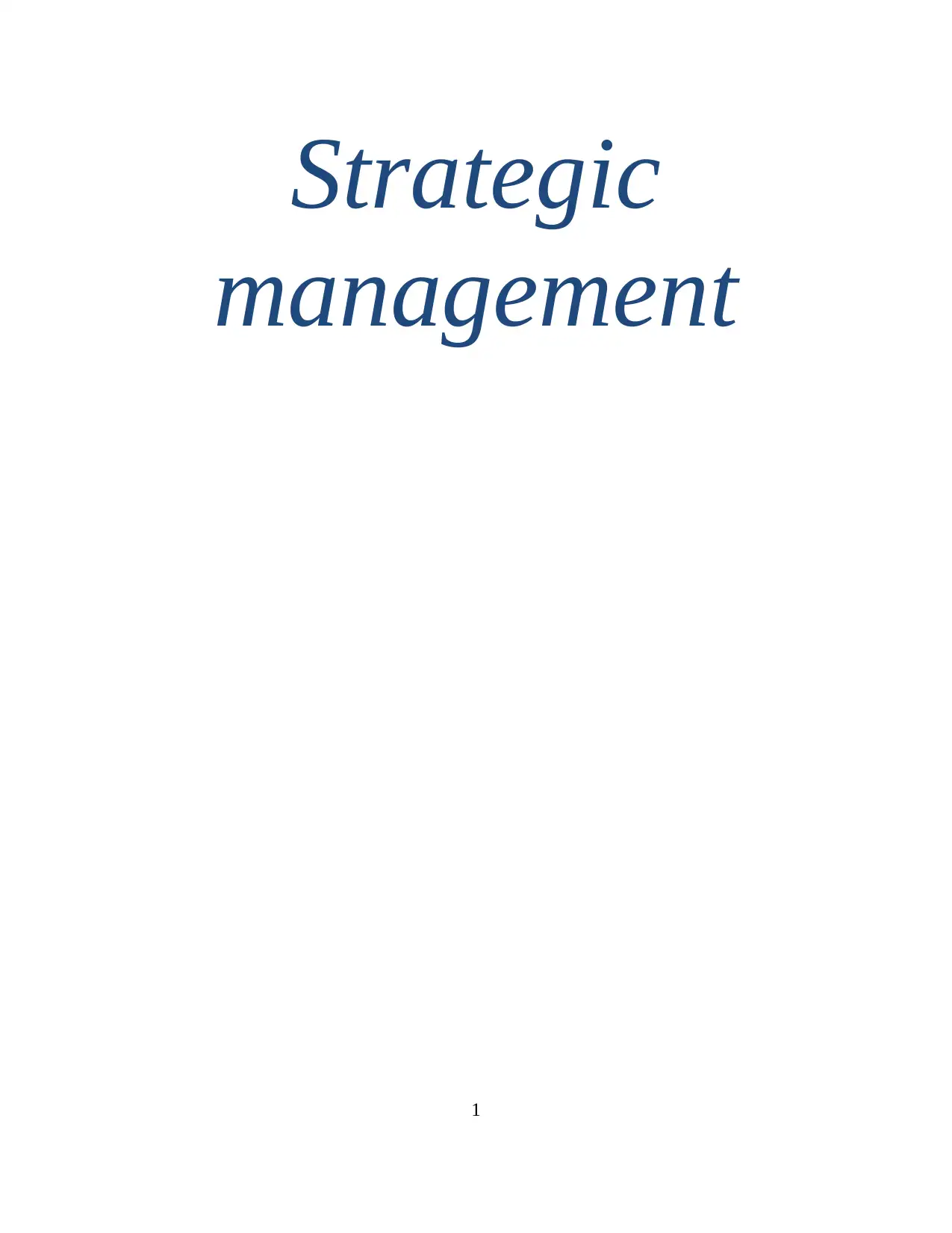
Strategic
management
1
management
1
Paraphrase This Document
Need a fresh take? Get an instant paraphrase of this document with our AI Paraphraser
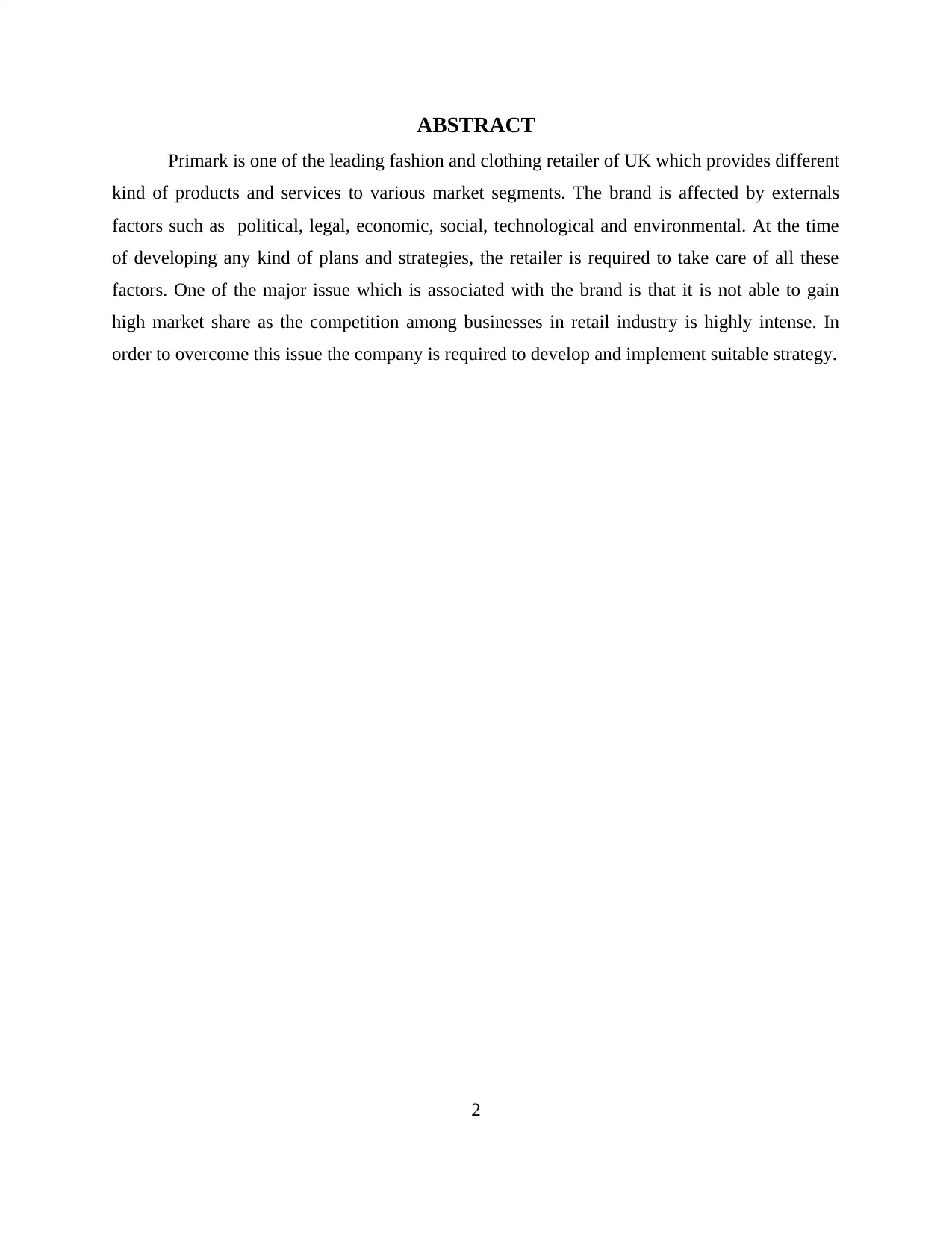
ABSTRACT
Primark is one of the leading fashion and clothing retailer of UK which provides different
kind of products and services to various market segments. The brand is affected by externals
factors such as political, legal, economic, social, technological and environmental. At the time
of developing any kind of plans and strategies, the retailer is required to take care of all these
factors. One of the major issue which is associated with the brand is that it is not able to gain
high market share as the competition among businesses in retail industry is highly intense. In
order to overcome this issue the company is required to develop and implement suitable strategy.
2
Primark is one of the leading fashion and clothing retailer of UK which provides different
kind of products and services to various market segments. The brand is affected by externals
factors such as political, legal, economic, social, technological and environmental. At the time
of developing any kind of plans and strategies, the retailer is required to take care of all these
factors. One of the major issue which is associated with the brand is that it is not able to gain
high market share as the competition among businesses in retail industry is highly intense. In
order to overcome this issue the company is required to develop and implement suitable strategy.
2
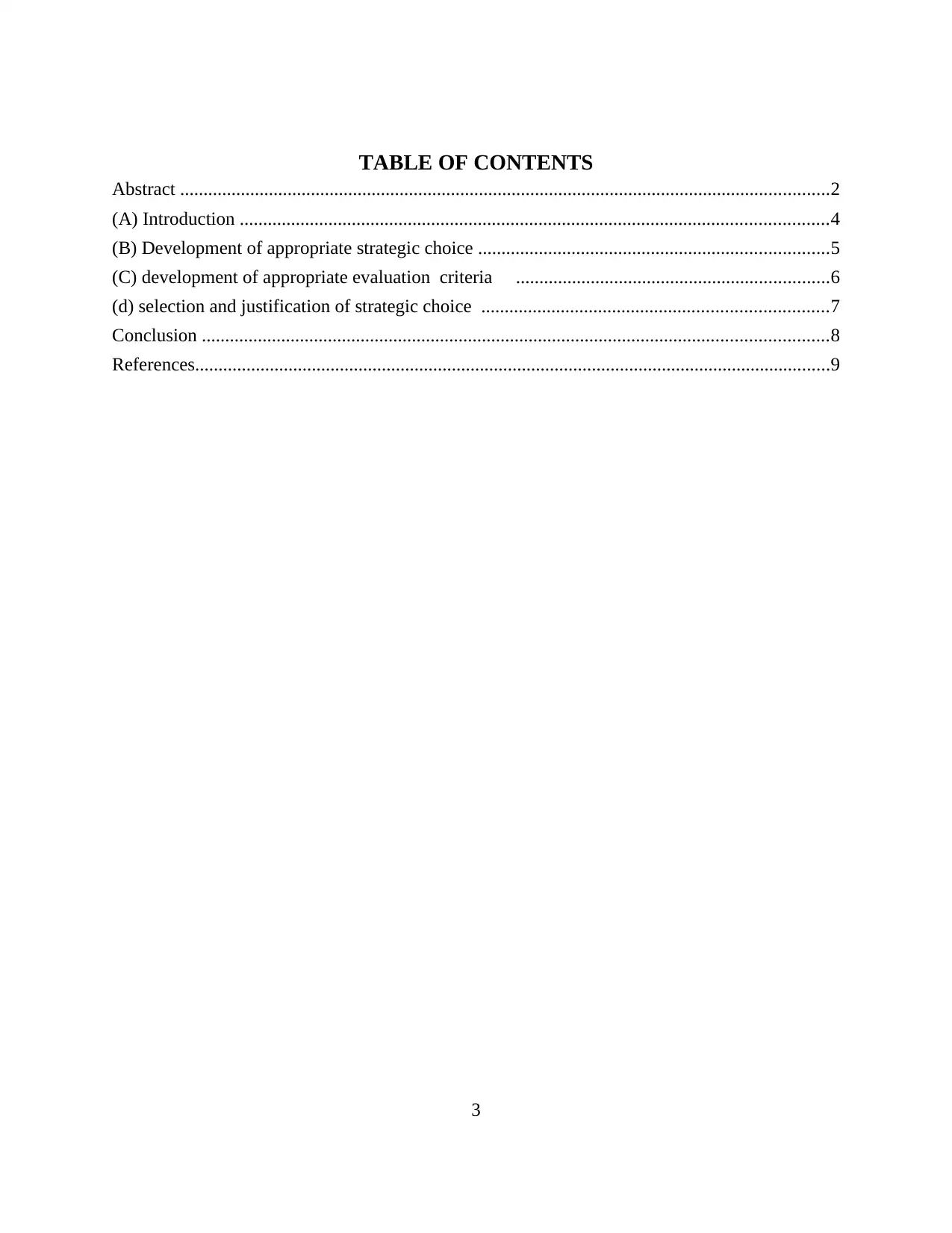
TABLE OF CONTENTS
Abstract ...........................................................................................................................................2
(A) Introduction ..............................................................................................................................4
(B) Development of appropriate strategic choice ...........................................................................5
(C) development of appropriate evaluation criteria ...................................................................6
(d) selection and justification of strategic choice ..........................................................................7
Conclusion ......................................................................................................................................8
References........................................................................................................................................9
3
Abstract ...........................................................................................................................................2
(A) Introduction ..............................................................................................................................4
(B) Development of appropriate strategic choice ...........................................................................5
(C) development of appropriate evaluation criteria ...................................................................6
(d) selection and justification of strategic choice ..........................................................................7
Conclusion ......................................................................................................................................8
References........................................................................................................................................9
3
⊘ This is a preview!⊘
Do you want full access?
Subscribe today to unlock all pages.

Trusted by 1+ million students worldwide
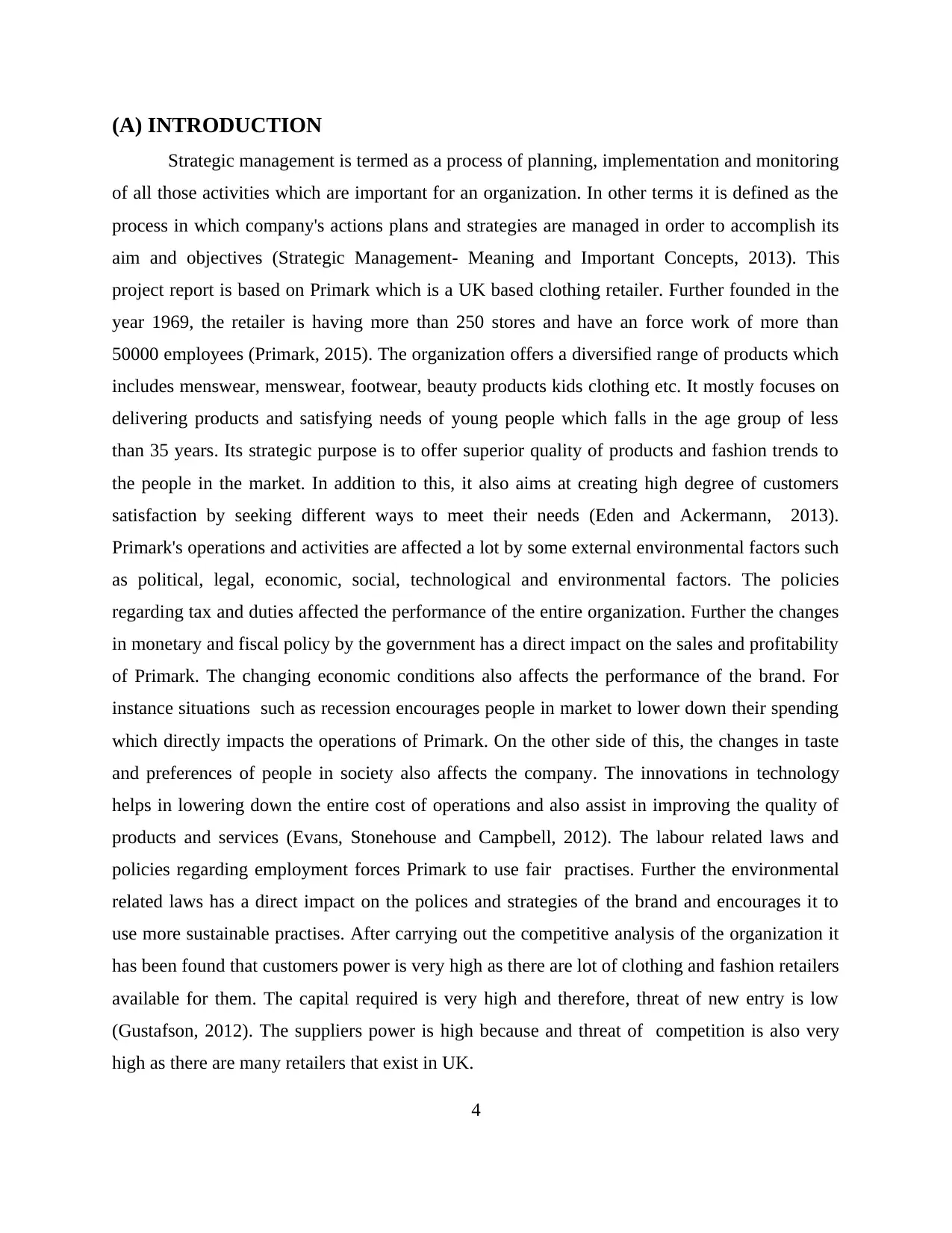
(A) INTRODUCTION
Strategic management is termed as a process of planning, implementation and monitoring
of all those activities which are important for an organization. In other terms it is defined as the
process in which company's actions plans and strategies are managed in order to accomplish its
aim and objectives (Strategic Management- Meaning and Important Concepts, 2013). This
project report is based on Primark which is a UK based clothing retailer. Further founded in the
year 1969, the retailer is having more than 250 stores and have an force work of more than
50000 employees (Primark, 2015). The organization offers a diversified range of products which
includes menswear, menswear, footwear, beauty products kids clothing etc. It mostly focuses on
delivering products and satisfying needs of young people which falls in the age group of less
than 35 years. Its strategic purpose is to offer superior quality of products and fashion trends to
the people in the market. In addition to this, it also aims at creating high degree of customers
satisfaction by seeking different ways to meet their needs (Eden and Ackermann, 2013).
Primark's operations and activities are affected a lot by some external environmental factors such
as political, legal, economic, social, technological and environmental factors. The policies
regarding tax and duties affected the performance of the entire organization. Further the changes
in monetary and fiscal policy by the government has a direct impact on the sales and profitability
of Primark. The changing economic conditions also affects the performance of the brand. For
instance situations such as recession encourages people in market to lower down their spending
which directly impacts the operations of Primark. On the other side of this, the changes in taste
and preferences of people in society also affects the company. The innovations in technology
helps in lowering down the entire cost of operations and also assist in improving the quality of
products and services (Evans, Stonehouse and Campbell, 2012). The labour related laws and
policies regarding employment forces Primark to use fair practises. Further the environmental
related laws has a direct impact on the polices and strategies of the brand and encourages it to
use more sustainable practises. After carrying out the competitive analysis of the organization it
has been found that customers power is very high as there are lot of clothing and fashion retailers
available for them. The capital required is very high and therefore, threat of new entry is low
(Gustafson, 2012). The suppliers power is high because and threat of competition is also very
high as there are many retailers that exist in UK.
4
Strategic management is termed as a process of planning, implementation and monitoring
of all those activities which are important for an organization. In other terms it is defined as the
process in which company's actions plans and strategies are managed in order to accomplish its
aim and objectives (Strategic Management- Meaning and Important Concepts, 2013). This
project report is based on Primark which is a UK based clothing retailer. Further founded in the
year 1969, the retailer is having more than 250 stores and have an force work of more than
50000 employees (Primark, 2015). The organization offers a diversified range of products which
includes menswear, menswear, footwear, beauty products kids clothing etc. It mostly focuses on
delivering products and satisfying needs of young people which falls in the age group of less
than 35 years. Its strategic purpose is to offer superior quality of products and fashion trends to
the people in the market. In addition to this, it also aims at creating high degree of customers
satisfaction by seeking different ways to meet their needs (Eden and Ackermann, 2013).
Primark's operations and activities are affected a lot by some external environmental factors such
as political, legal, economic, social, technological and environmental factors. The policies
regarding tax and duties affected the performance of the entire organization. Further the changes
in monetary and fiscal policy by the government has a direct impact on the sales and profitability
of Primark. The changing economic conditions also affects the performance of the brand. For
instance situations such as recession encourages people in market to lower down their spending
which directly impacts the operations of Primark. On the other side of this, the changes in taste
and preferences of people in society also affects the company. The innovations in technology
helps in lowering down the entire cost of operations and also assist in improving the quality of
products and services (Evans, Stonehouse and Campbell, 2012). The labour related laws and
policies regarding employment forces Primark to use fair practises. Further the environmental
related laws has a direct impact on the polices and strategies of the brand and encourages it to
use more sustainable practises. After carrying out the competitive analysis of the organization it
has been found that customers power is very high as there are lot of clothing and fashion retailers
available for them. The capital required is very high and therefore, threat of new entry is low
(Gustafson, 2012). The suppliers power is high because and threat of competition is also very
high as there are many retailers that exist in UK.
4
Paraphrase This Document
Need a fresh take? Get an instant paraphrase of this document with our AI Paraphraser
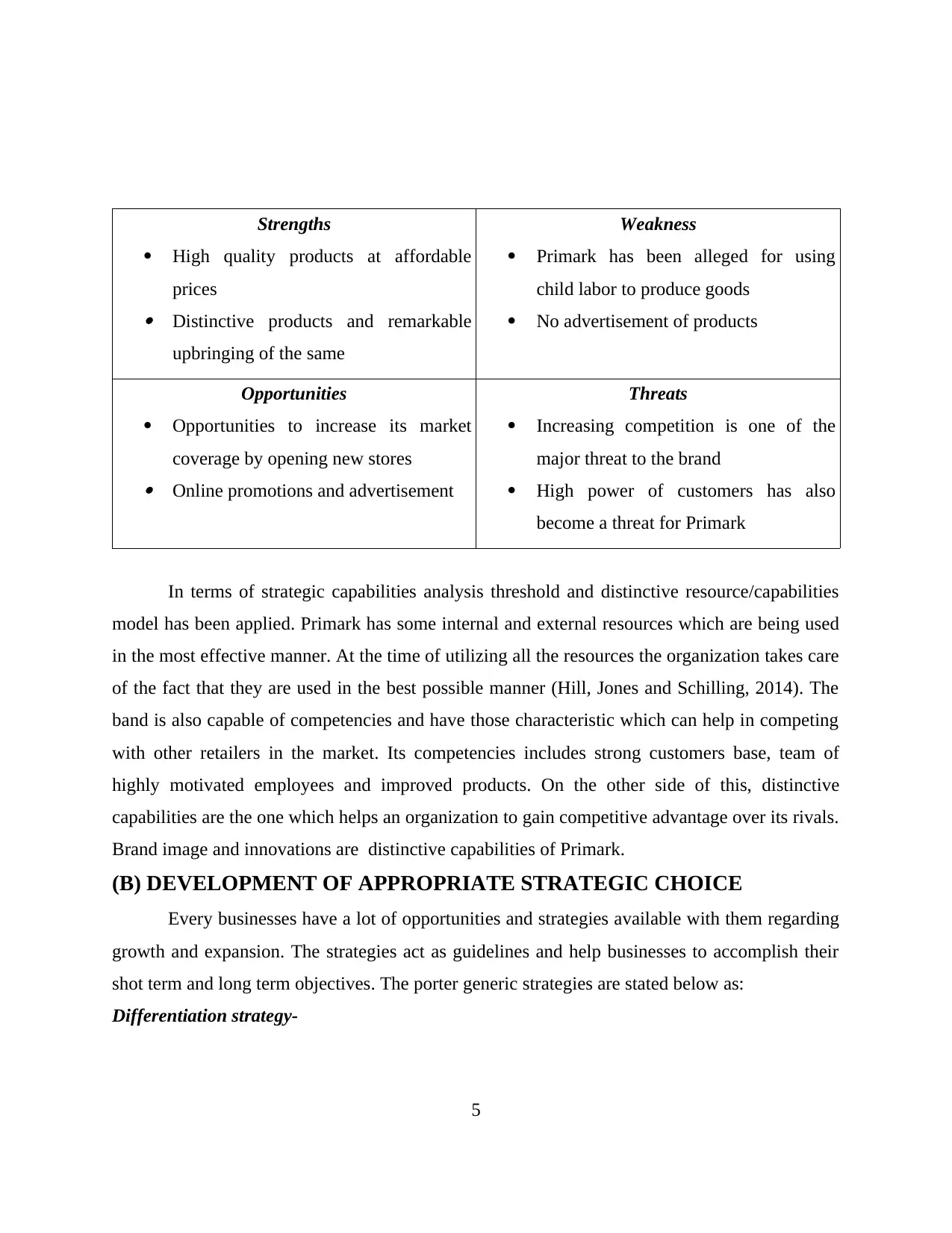
Strengths
High quality products at affordable
prices Distinctive products and remarkable
upbringing of the same
Weakness
Primark has been alleged for using
child labor to produce goods
No advertisement of products
Opportunities
Opportunities to increase its market
coverage by opening new stores Online promotions and advertisement
Threats
Increasing competition is one of the
major threat to the brand
High power of customers has also
become a threat for Primark
In terms of strategic capabilities analysis threshold and distinctive resource/capabilities
model has been applied. Primark has some internal and external resources which are being used
in the most effective manner. At the time of utilizing all the resources the organization takes care
of the fact that they are used in the best possible manner (Hill, Jones and Schilling, 2014). The
band is also capable of competencies and have those characteristic which can help in competing
with other retailers in the market. Its competencies includes strong customers base, team of
highly motivated employees and improved products. On the other side of this, distinctive
capabilities are the one which helps an organization to gain competitive advantage over its rivals.
Brand image and innovations are distinctive capabilities of Primark.
(B) DEVELOPMENT OF APPROPRIATE STRATEGIC CHOICE
Every businesses have a lot of opportunities and strategies available with them regarding
growth and expansion. The strategies act as guidelines and help businesses to accomplish their
shot term and long term objectives. The porter generic strategies are stated below as:
Differentiation strategy-
5
High quality products at affordable
prices Distinctive products and remarkable
upbringing of the same
Weakness
Primark has been alleged for using
child labor to produce goods
No advertisement of products
Opportunities
Opportunities to increase its market
coverage by opening new stores Online promotions and advertisement
Threats
Increasing competition is one of the
major threat to the brand
High power of customers has also
become a threat for Primark
In terms of strategic capabilities analysis threshold and distinctive resource/capabilities
model has been applied. Primark has some internal and external resources which are being used
in the most effective manner. At the time of utilizing all the resources the organization takes care
of the fact that they are used in the best possible manner (Hill, Jones and Schilling, 2014). The
band is also capable of competencies and have those characteristic which can help in competing
with other retailers in the market. Its competencies includes strong customers base, team of
highly motivated employees and improved products. On the other side of this, distinctive
capabilities are the one which helps an organization to gain competitive advantage over its rivals.
Brand image and innovations are distinctive capabilities of Primark.
(B) DEVELOPMENT OF APPROPRIATE STRATEGIC CHOICE
Every businesses have a lot of opportunities and strategies available with them regarding
growth and expansion. The strategies act as guidelines and help businesses to accomplish their
shot term and long term objectives. The porter generic strategies are stated below as:
Differentiation strategy-
5
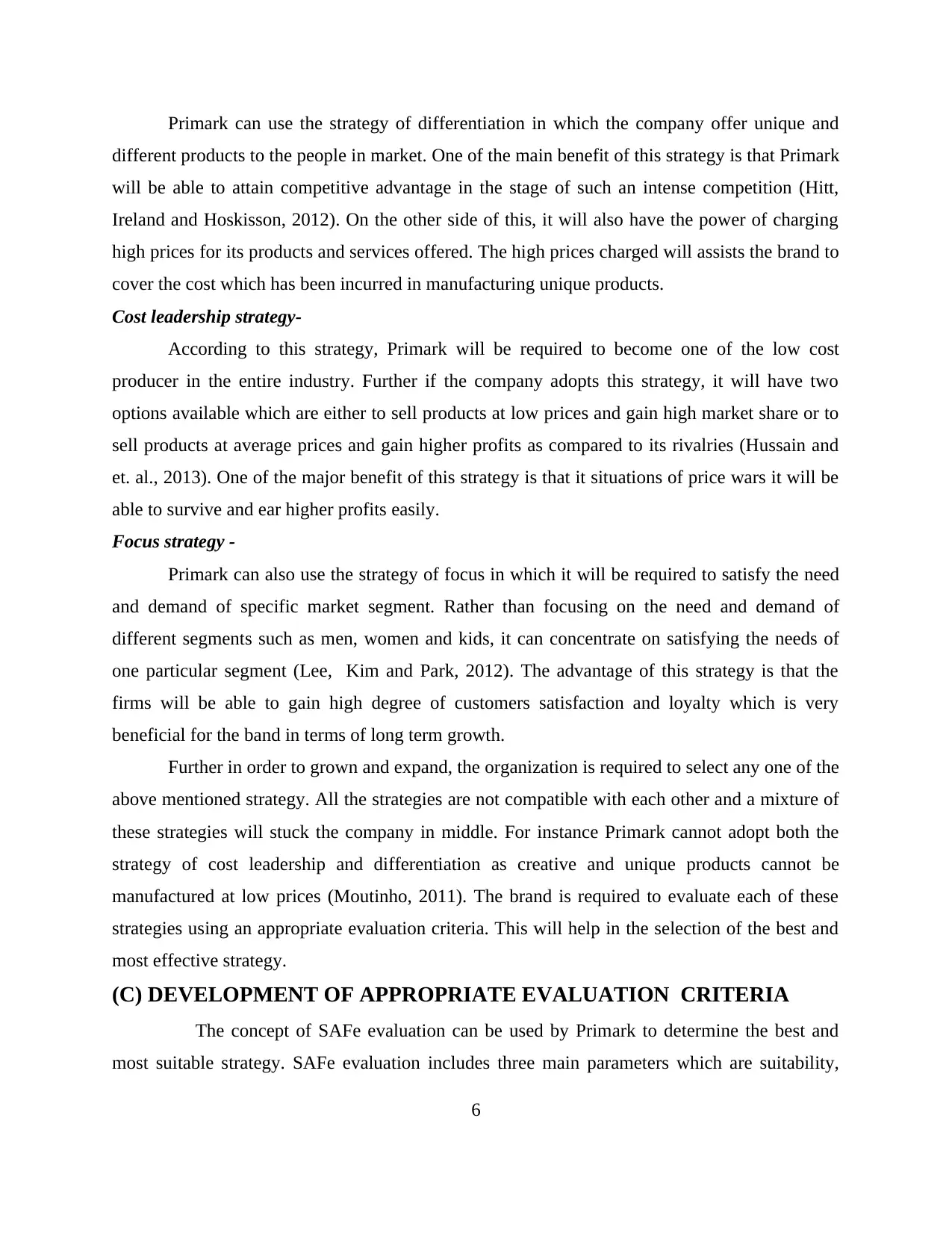
Primark can use the strategy of differentiation in which the company offer unique and
different products to the people in market. One of the main benefit of this strategy is that Primark
will be able to attain competitive advantage in the stage of such an intense competition (Hitt,
Ireland and Hoskisson, 2012). On the other side of this, it will also have the power of charging
high prices for its products and services offered. The high prices charged will assists the brand to
cover the cost which has been incurred in manufacturing unique products.
Cost leadership strategy-
According to this strategy, Primark will be required to become one of the low cost
producer in the entire industry. Further if the company adopts this strategy, it will have two
options available which are either to sell products at low prices and gain high market share or to
sell products at average prices and gain higher profits as compared to its rivalries (Hussain and
et. al., 2013). One of the major benefit of this strategy is that it situations of price wars it will be
able to survive and ear higher profits easily.
Focus strategy -
Primark can also use the strategy of focus in which it will be required to satisfy the need
and demand of specific market segment. Rather than focusing on the need and demand of
different segments such as men, women and kids, it can concentrate on satisfying the needs of
one particular segment (Lee, Kim and Park, 2012). The advantage of this strategy is that the
firms will be able to gain high degree of customers satisfaction and loyalty which is very
beneficial for the band in terms of long term growth.
Further in order to grown and expand, the organization is required to select any one of the
above mentioned strategy. All the strategies are not compatible with each other and a mixture of
these strategies will stuck the company in middle. For instance Primark cannot adopt both the
strategy of cost leadership and differentiation as creative and unique products cannot be
manufactured at low prices (Moutinho, 2011). The brand is required to evaluate each of these
strategies using an appropriate evaluation criteria. This will help in the selection of the best and
most effective strategy.
(C) DEVELOPMENT OF APPROPRIATE EVALUATION CRITERIA
The concept of SAFe evaluation can be used by Primark to determine the best and
most suitable strategy. SAFe evaluation includes three main parameters which are suitability,
6
different products to the people in market. One of the main benefit of this strategy is that Primark
will be able to attain competitive advantage in the stage of such an intense competition (Hitt,
Ireland and Hoskisson, 2012). On the other side of this, it will also have the power of charging
high prices for its products and services offered. The high prices charged will assists the brand to
cover the cost which has been incurred in manufacturing unique products.
Cost leadership strategy-
According to this strategy, Primark will be required to become one of the low cost
producer in the entire industry. Further if the company adopts this strategy, it will have two
options available which are either to sell products at low prices and gain high market share or to
sell products at average prices and gain higher profits as compared to its rivalries (Hussain and
et. al., 2013). One of the major benefit of this strategy is that it situations of price wars it will be
able to survive and ear higher profits easily.
Focus strategy -
Primark can also use the strategy of focus in which it will be required to satisfy the need
and demand of specific market segment. Rather than focusing on the need and demand of
different segments such as men, women and kids, it can concentrate on satisfying the needs of
one particular segment (Lee, Kim and Park, 2012). The advantage of this strategy is that the
firms will be able to gain high degree of customers satisfaction and loyalty which is very
beneficial for the band in terms of long term growth.
Further in order to grown and expand, the organization is required to select any one of the
above mentioned strategy. All the strategies are not compatible with each other and a mixture of
these strategies will stuck the company in middle. For instance Primark cannot adopt both the
strategy of cost leadership and differentiation as creative and unique products cannot be
manufactured at low prices (Moutinho, 2011). The brand is required to evaluate each of these
strategies using an appropriate evaluation criteria. This will help in the selection of the best and
most effective strategy.
(C) DEVELOPMENT OF APPROPRIATE EVALUATION CRITERIA
The concept of SAFe evaluation can be used by Primark to determine the best and
most suitable strategy. SAFe evaluation includes three main parameters which are suitability,
6
⊘ This is a preview!⊘
Do you want full access?
Subscribe today to unlock all pages.

Trusted by 1+ million students worldwide
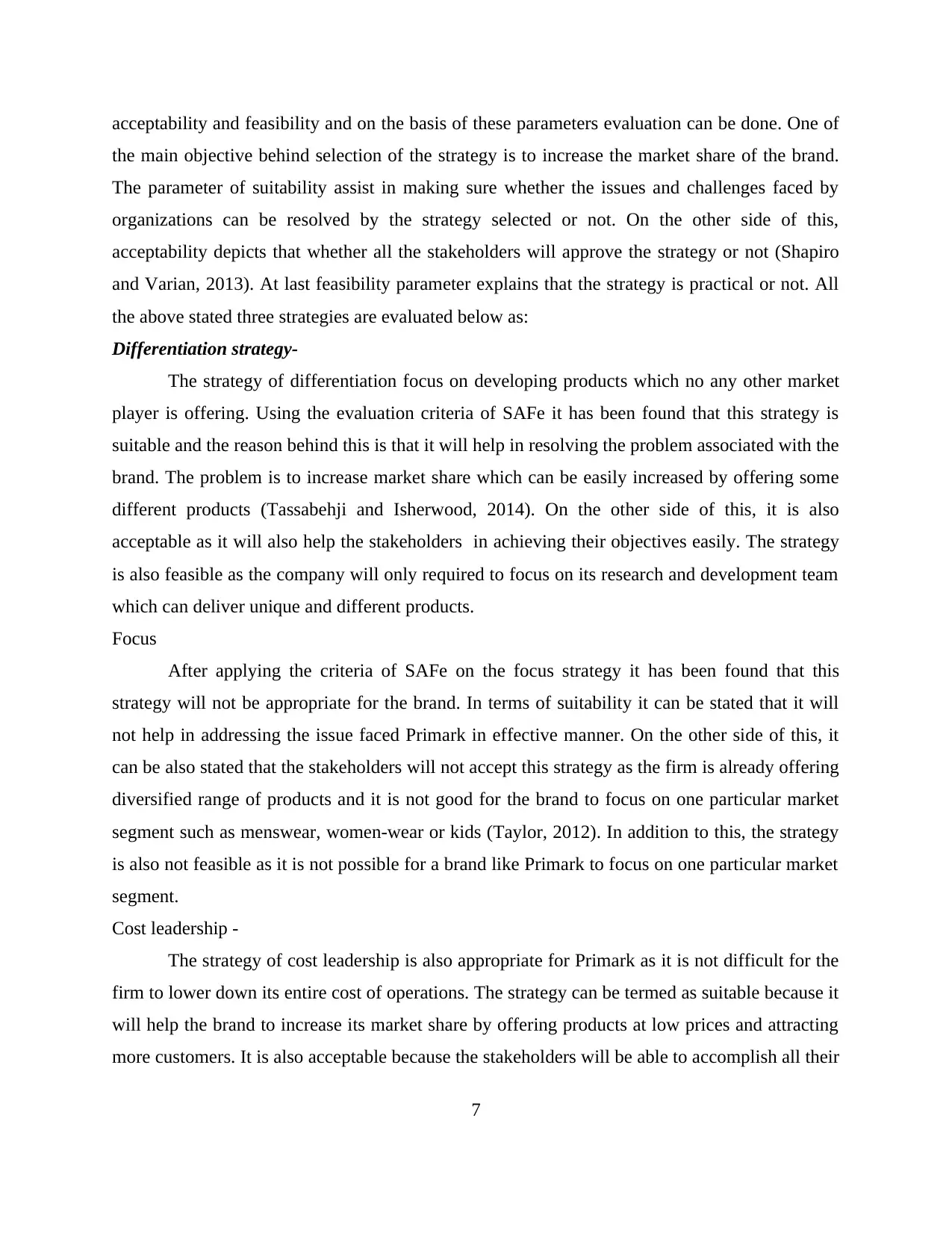
acceptability and feasibility and on the basis of these parameters evaluation can be done. One of
the main objective behind selection of the strategy is to increase the market share of the brand.
The parameter of suitability assist in making sure whether the issues and challenges faced by
organizations can be resolved by the strategy selected or not. On the other side of this,
acceptability depicts that whether all the stakeholders will approve the strategy or not (Shapiro
and Varian, 2013). At last feasibility parameter explains that the strategy is practical or not. All
the above stated three strategies are evaluated below as:
Differentiation strategy-
The strategy of differentiation focus on developing products which no any other market
player is offering. Using the evaluation criteria of SAFe it has been found that this strategy is
suitable and the reason behind this is that it will help in resolving the problem associated with the
brand. The problem is to increase market share which can be easily increased by offering some
different products (Tassabehji and Isherwood, 2014). On the other side of this, it is also
acceptable as it will also help the stakeholders in achieving their objectives easily. The strategy
is also feasible as the company will only required to focus on its research and development team
which can deliver unique and different products.
Focus
After applying the criteria of SAFe on the focus strategy it has been found that this
strategy will not be appropriate for the brand. In terms of suitability it can be stated that it will
not help in addressing the issue faced Primark in effective manner. On the other side of this, it
can be also stated that the stakeholders will not accept this strategy as the firm is already offering
diversified range of products and it is not good for the brand to focus on one particular market
segment such as menswear, women-wear or kids (Taylor, 2012). In addition to this, the strategy
is also not feasible as it is not possible for a brand like Primark to focus on one particular market
segment.
Cost leadership -
The strategy of cost leadership is also appropriate for Primark as it is not difficult for the
firm to lower down its entire cost of operations. The strategy can be termed as suitable because it
will help the brand to increase its market share by offering products at low prices and attracting
more customers. It is also acceptable because the stakeholders will be able to accomplish all their
7
the main objective behind selection of the strategy is to increase the market share of the brand.
The parameter of suitability assist in making sure whether the issues and challenges faced by
organizations can be resolved by the strategy selected or not. On the other side of this,
acceptability depicts that whether all the stakeholders will approve the strategy or not (Shapiro
and Varian, 2013). At last feasibility parameter explains that the strategy is practical or not. All
the above stated three strategies are evaluated below as:
Differentiation strategy-
The strategy of differentiation focus on developing products which no any other market
player is offering. Using the evaluation criteria of SAFe it has been found that this strategy is
suitable and the reason behind this is that it will help in resolving the problem associated with the
brand. The problem is to increase market share which can be easily increased by offering some
different products (Tassabehji and Isherwood, 2014). On the other side of this, it is also
acceptable as it will also help the stakeholders in achieving their objectives easily. The strategy
is also feasible as the company will only required to focus on its research and development team
which can deliver unique and different products.
Focus
After applying the criteria of SAFe on the focus strategy it has been found that this
strategy will not be appropriate for the brand. In terms of suitability it can be stated that it will
not help in addressing the issue faced Primark in effective manner. On the other side of this, it
can be also stated that the stakeholders will not accept this strategy as the firm is already offering
diversified range of products and it is not good for the brand to focus on one particular market
segment such as menswear, women-wear or kids (Taylor, 2012). In addition to this, the strategy
is also not feasible as it is not possible for a brand like Primark to focus on one particular market
segment.
Cost leadership -
The strategy of cost leadership is also appropriate for Primark as it is not difficult for the
firm to lower down its entire cost of operations. The strategy can be termed as suitable because it
will help the brand to increase its market share by offering products at low prices and attracting
more customers. It is also acceptable because the stakeholders will be able to accomplish all their
7
Paraphrase This Document
Need a fresh take? Get an instant paraphrase of this document with our AI Paraphraser
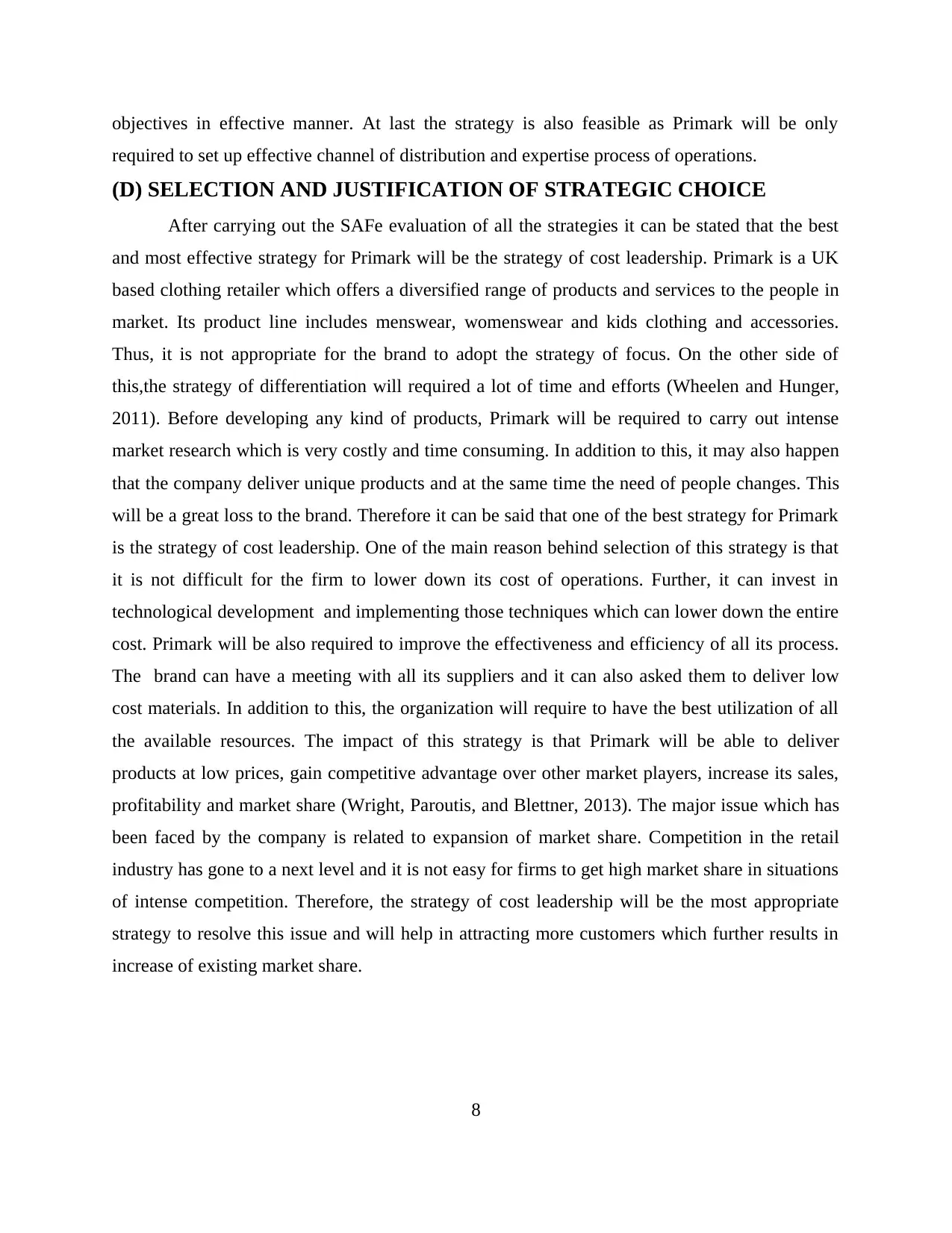
objectives in effective manner. At last the strategy is also feasible as Primark will be only
required to set up effective channel of distribution and expertise process of operations.
(D) SELECTION AND JUSTIFICATION OF STRATEGIC CHOICE
After carrying out the SAFe evaluation of all the strategies it can be stated that the best
and most effective strategy for Primark will be the strategy of cost leadership. Primark is a UK
based clothing retailer which offers a diversified range of products and services to the people in
market. Its product line includes menswear, womenswear and kids clothing and accessories.
Thus, it is not appropriate for the brand to adopt the strategy of focus. On the other side of
this,the strategy of differentiation will required a lot of time and efforts (Wheelen and Hunger,
2011). Before developing any kind of products, Primark will be required to carry out intense
market research which is very costly and time consuming. In addition to this, it may also happen
that the company deliver unique products and at the same time the need of people changes. This
will be a great loss to the brand. Therefore it can be said that one of the best strategy for Primark
is the strategy of cost leadership. One of the main reason behind selection of this strategy is that
it is not difficult for the firm to lower down its cost of operations. Further, it can invest in
technological development and implementing those techniques which can lower down the entire
cost. Primark will be also required to improve the effectiveness and efficiency of all its process.
The brand can have a meeting with all its suppliers and it can also asked them to deliver low
cost materials. In addition to this, the organization will require to have the best utilization of all
the available resources. The impact of this strategy is that Primark will be able to deliver
products at low prices, gain competitive advantage over other market players, increase its sales,
profitability and market share (Wright, Paroutis, and Blettner, 2013). The major issue which has
been faced by the company is related to expansion of market share. Competition in the retail
industry has gone to a next level and it is not easy for firms to get high market share in situations
of intense competition. Therefore, the strategy of cost leadership will be the most appropriate
strategy to resolve this issue and will help in attracting more customers which further results in
increase of existing market share.
8
required to set up effective channel of distribution and expertise process of operations.
(D) SELECTION AND JUSTIFICATION OF STRATEGIC CHOICE
After carrying out the SAFe evaluation of all the strategies it can be stated that the best
and most effective strategy for Primark will be the strategy of cost leadership. Primark is a UK
based clothing retailer which offers a diversified range of products and services to the people in
market. Its product line includes menswear, womenswear and kids clothing and accessories.
Thus, it is not appropriate for the brand to adopt the strategy of focus. On the other side of
this,the strategy of differentiation will required a lot of time and efforts (Wheelen and Hunger,
2011). Before developing any kind of products, Primark will be required to carry out intense
market research which is very costly and time consuming. In addition to this, it may also happen
that the company deliver unique products and at the same time the need of people changes. This
will be a great loss to the brand. Therefore it can be said that one of the best strategy for Primark
is the strategy of cost leadership. One of the main reason behind selection of this strategy is that
it is not difficult for the firm to lower down its cost of operations. Further, it can invest in
technological development and implementing those techniques which can lower down the entire
cost. Primark will be also required to improve the effectiveness and efficiency of all its process.
The brand can have a meeting with all its suppliers and it can also asked them to deliver low
cost materials. In addition to this, the organization will require to have the best utilization of all
the available resources. The impact of this strategy is that Primark will be able to deliver
products at low prices, gain competitive advantage over other market players, increase its sales,
profitability and market share (Wright, Paroutis, and Blettner, 2013). The major issue which has
been faced by the company is related to expansion of market share. Competition in the retail
industry has gone to a next level and it is not easy for firms to get high market share in situations
of intense competition. Therefore, the strategy of cost leadership will be the most appropriate
strategy to resolve this issue and will help in attracting more customers which further results in
increase of existing market share.
8
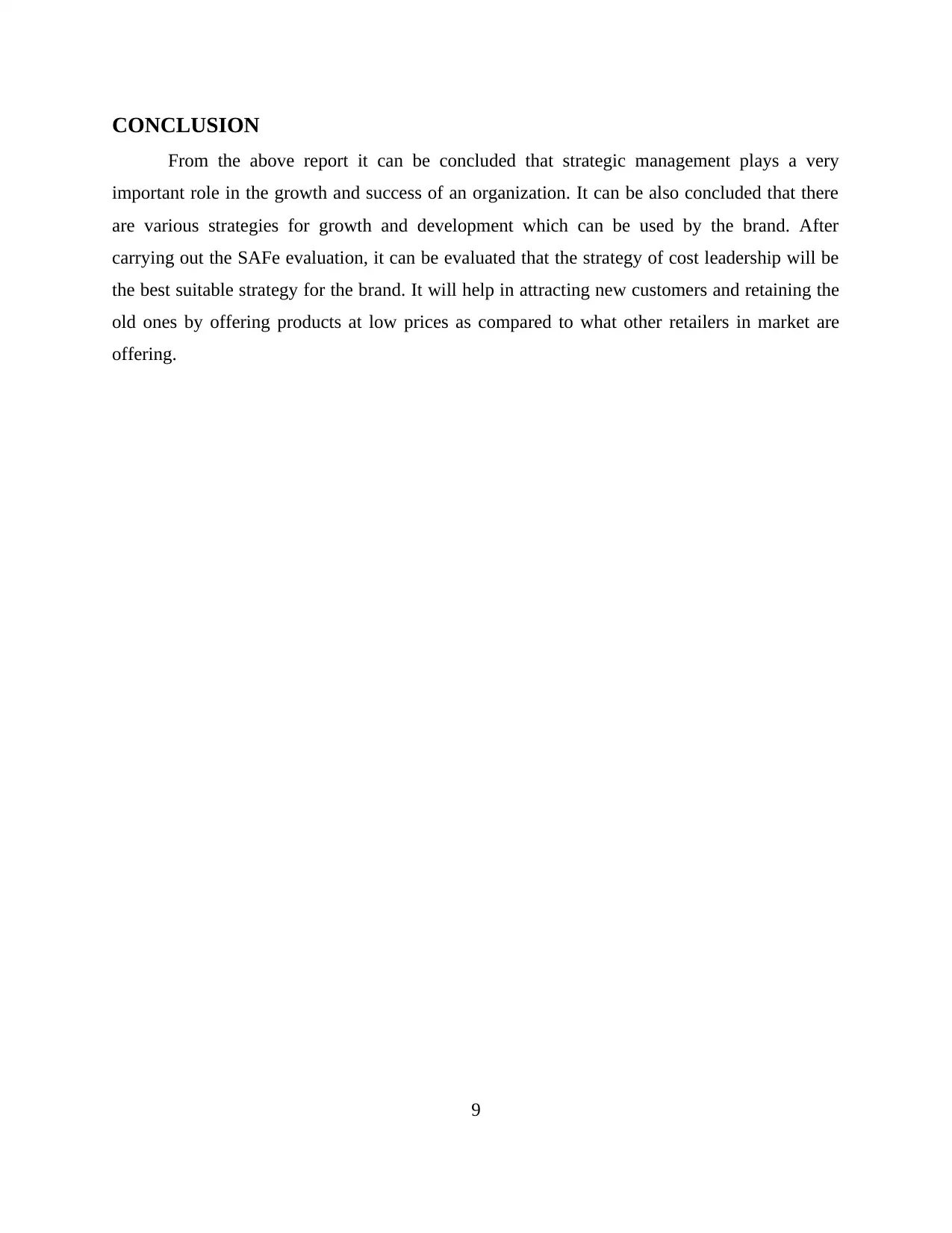
CONCLUSION
From the above report it can be concluded that strategic management plays a very
important role in the growth and success of an organization. It can be also concluded that there
are various strategies for growth and development which can be used by the brand. After
carrying out the SAFe evaluation, it can be evaluated that the strategy of cost leadership will be
the best suitable strategy for the brand. It will help in attracting new customers and retaining the
old ones by offering products at low prices as compared to what other retailers in market are
offering.
9
From the above report it can be concluded that strategic management plays a very
important role in the growth and success of an organization. It can be also concluded that there
are various strategies for growth and development which can be used by the brand. After
carrying out the SAFe evaluation, it can be evaluated that the strategy of cost leadership will be
the best suitable strategy for the brand. It will help in attracting new customers and retaining the
old ones by offering products at low prices as compared to what other retailers in market are
offering.
9
⊘ This is a preview!⊘
Do you want full access?
Subscribe today to unlock all pages.

Trusted by 1+ million students worldwide
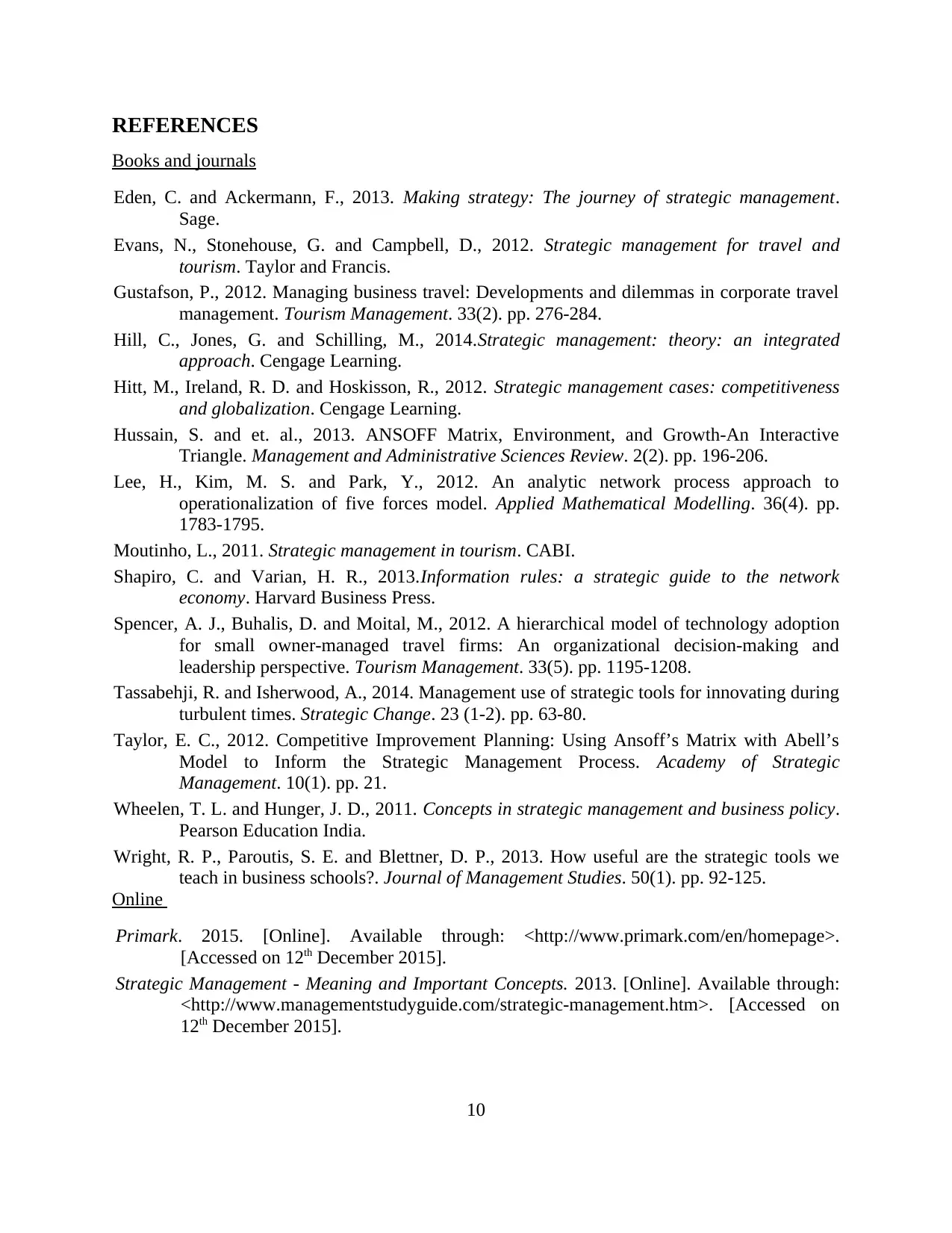
REFERENCES
Books and journals
Eden, C. and Ackermann, F., 2013. Making strategy: The journey of strategic management.
Sage.
Evans, N., Stonehouse, G. and Campbell, D., 2012. Strategic management for travel and
tourism. Taylor and Francis.
Gustafson, P., 2012. Managing business travel: Developments and dilemmas in corporate travel
management. Tourism Management. 33(2). pp. 276-284.
Hill, C., Jones, G. and Schilling, M., 2014.Strategic management: theory: an integrated
approach. Cengage Learning.
Hitt, M., Ireland, R. D. and Hoskisson, R., 2012. Strategic management cases: competitiveness
and globalization. Cengage Learning.
Hussain, S. and et. al., 2013. ANSOFF Matrix, Environment, and Growth-An Interactive
Triangle. Management and Administrative Sciences Review. 2(2). pp. 196-206.
Lee, H., Kim, M. S. and Park, Y., 2012. An analytic network process approach to
operationalization of five forces model. Applied Mathematical Modelling. 36(4). pp.
1783-1795.
Moutinho, L., 2011. Strategic management in tourism. CABI.
Shapiro, C. and Varian, H. R., 2013.Information rules: a strategic guide to the network
economy. Harvard Business Press.
Spencer, A. J., Buhalis, D. and Moital, M., 2012. A hierarchical model of technology adoption
for small owner-managed travel firms: An organizational decision-making and
leadership perspective. Tourism Management. 33(5). pp. 1195-1208.
Tassabehji, R. and Isherwood, A., 2014. Management use of strategic tools for innovating during
turbulent times. Strategic Change. 23 (1‐2). pp. 63-80.
Taylor, E. C., 2012. Competitive Improvement Planning: Using Ansoff’s Matrix with Abell’s
Model to Inform the Strategic Management Process. Academy of Strategic
Management. 10(1). pp. 21.
Wheelen, T. L. and Hunger, J. D., 2011. Concepts in strategic management and business policy.
Pearson Education India.
Wright, R. P., Paroutis, S. E. and Blettner, D. P., 2013. How useful are the strategic tools we
teach in business schools?. Journal of Management Studies. 50(1). pp. 92-125.
Online
Primark. 2015. [Online]. Available through: <http://www.primark.com/en/homepage>.
[Accessed on 12th December 2015].
Strategic Management - Meaning and Important Concepts. 2013. [Online]. Available through:
<http://www.managementstudyguide.com/strategic-management.htm>. [Accessed on
12th December 2015].
10
Books and journals
Eden, C. and Ackermann, F., 2013. Making strategy: The journey of strategic management.
Sage.
Evans, N., Stonehouse, G. and Campbell, D., 2012. Strategic management for travel and
tourism. Taylor and Francis.
Gustafson, P., 2012. Managing business travel: Developments and dilemmas in corporate travel
management. Tourism Management. 33(2). pp. 276-284.
Hill, C., Jones, G. and Schilling, M., 2014.Strategic management: theory: an integrated
approach. Cengage Learning.
Hitt, M., Ireland, R. D. and Hoskisson, R., 2012. Strategic management cases: competitiveness
and globalization. Cengage Learning.
Hussain, S. and et. al., 2013. ANSOFF Matrix, Environment, and Growth-An Interactive
Triangle. Management and Administrative Sciences Review. 2(2). pp. 196-206.
Lee, H., Kim, M. S. and Park, Y., 2012. An analytic network process approach to
operationalization of five forces model. Applied Mathematical Modelling. 36(4). pp.
1783-1795.
Moutinho, L., 2011. Strategic management in tourism. CABI.
Shapiro, C. and Varian, H. R., 2013.Information rules: a strategic guide to the network
economy. Harvard Business Press.
Spencer, A. J., Buhalis, D. and Moital, M., 2012. A hierarchical model of technology adoption
for small owner-managed travel firms: An organizational decision-making and
leadership perspective. Tourism Management. 33(5). pp. 1195-1208.
Tassabehji, R. and Isherwood, A., 2014. Management use of strategic tools for innovating during
turbulent times. Strategic Change. 23 (1‐2). pp. 63-80.
Taylor, E. C., 2012. Competitive Improvement Planning: Using Ansoff’s Matrix with Abell’s
Model to Inform the Strategic Management Process. Academy of Strategic
Management. 10(1). pp. 21.
Wheelen, T. L. and Hunger, J. D., 2011. Concepts in strategic management and business policy.
Pearson Education India.
Wright, R. P., Paroutis, S. E. and Blettner, D. P., 2013. How useful are the strategic tools we
teach in business schools?. Journal of Management Studies. 50(1). pp. 92-125.
Online
Primark. 2015. [Online]. Available through: <http://www.primark.com/en/homepage>.
[Accessed on 12th December 2015].
Strategic Management - Meaning and Important Concepts. 2013. [Online]. Available through:
<http://www.managementstudyguide.com/strategic-management.htm>. [Accessed on
12th December 2015].
10
1 out of 10
Related Documents
Your All-in-One AI-Powered Toolkit for Academic Success.
+13062052269
info@desklib.com
Available 24*7 on WhatsApp / Email
![[object Object]](/_next/static/media/star-bottom.7253800d.svg)
Unlock your academic potential
Copyright © 2020–2025 A2Z Services. All Rights Reserved. Developed and managed by ZUCOL.





